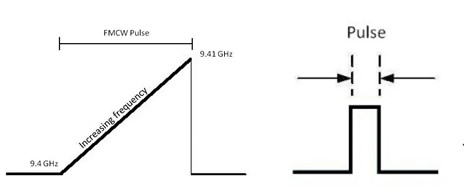
Broadband Radar
Better than conventional radar?
Broadband radar
The manufacturers of the new Broadband Radar claim it has many benefits over conventional radar including; low power, low radiation emission, no radar warm up time, clearer picture and little tuning required. Bold words indeed, but how do they do it?
How it works
Broadband radar is a generic term for Frequency Modulated Continuous Wave (FMCW) which is a new way to achieve radar signals. The ‘Broadband’ tag comes from the broad band of frequency it uses to interrogate a target. In fact FMCW compares changes in frequency between the transmitted and received signals to calculate range, instead of the conventional system of timing the interval between outgoing and returning signals.
FMCW Pulse
At low power, FMCW radar sends out a long pulse lasting about one thousandth of a second. Conventional radar sends out a short pulse but at very high power.


The longer FMCW pulse steadily increases its frequency and the range of the target is identified by calculating the difference between the returning frequency and the current frequency transmitted.
When the pulse reflects off an object it returns to the receiver at the same frequency at which it was sent. However the transmitting frequency will have steadily increased. The difference between the current transmitting frequency and the returned frequency allows the range to be calculated.
To constantly receive changes in frequency, the FMCW scanner transmits and receives simultaneously making it highly responsive.
This is only possible due to the low power pulse. Conventional scanners output 2000w and have to constantly switch between transmit and receive, but the 70w output from FMCW radar allows it to receive and transmit simultaneously.
Advantages
No warm up – instant on
Conventional radars use a magnetron to generate high power microwave energy. Magnetrons need warming up to work effectively, therefore the radar takes a few minutes before it can be used. Low power FMCW radar uses a solid state technology instead allowing it to be instantly on.
Low power
Conventional radars use pulses of high power for short periods of time; FMCW uses lower power for longer; this results in about a 30% reduction in power and very little output in standby mode.
Low emissions
Radar scanners emit radiation. Conventional radars suggest safe working distances of 1-3 metres from the scanner. Emission tests indicate FTCW emissions are similar to a mobile phone.
Better discrimination
Low power and continual receiving and transmitting of the signal suggests FTCW will receive echoes from very close to the boat whereas conventional radar sometimes blots them out. This allows targets to be received within a few metres of the boat so great for pilotage. They also better interpret targets that are behind one another.
The clearer picture and lack of clutter may mean less tuning by the operator, so simpler use.

Inside of the scanner - dual microwave strip antennas allowing simultaneous transmission and reception.
Drawbacks
Range
Overall range is lower than conventional radar. FMCW effective range is about 16 miles, whilst it states 24 miles with reduced performance. However, as radar range is governed by ‘line of sight’, most small craft can only ‘see’ 10 -15 miles anyway, unless they are looking at high ground.
SARTs, RACONs and Radar Target Enhancers
The low power FMCW pulse may not trigger a RACON (RAdar beaCON), SART (Search And Rescue Transponder) or even the active radar transponders which are increasingly fitted to leisure boats.
Conclusion
FMCW radar is a major break though in marine radar. It has many advantages over conventional radar and a few disadvantages. It is early days for FMCW in the marine world although it has been used for some time in air, land and military applications. Over the next few years it will be interesting to see how it makes an impact in the marine market.
Contact UsArticle Published: April 28, 2011 9:33
Article Updated: August 19, 2013 15:54